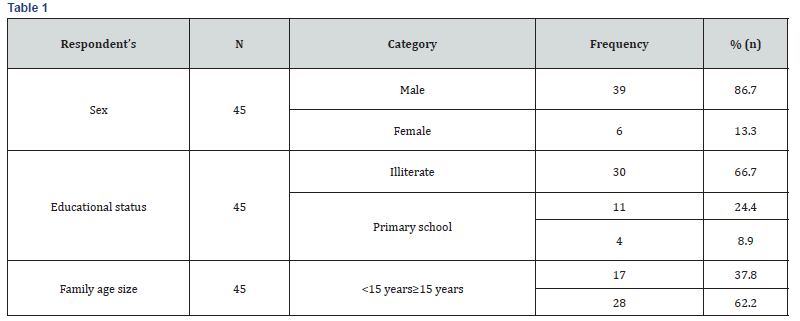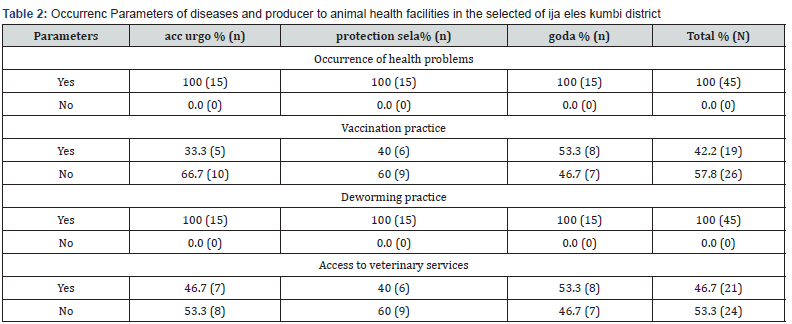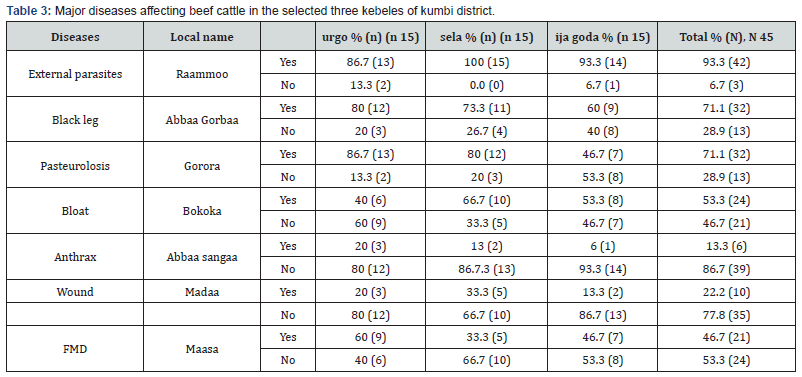Study on the status of Major Animal Health Problems that Impact on Cattle fattening with public health and Economic significant in selected kebeles of kumbi District, East Harerghe Zone, Ethiopia
Asledin Mohammed*
Kumbi Woreda Veterinary clinic and Agricultural Office, East Hararghe Zone, Ethiopia
Submission:March 01, 2024;Published:March 19, 2024
*Corresponding author: Asledin Mohammed, Kumbi Woreda Veterinary clinic and Agricultural Office, East Hararghe Zone, Ethiopia. Email: drasledin2023@gmail.com
How to cite this article: Asledin Mohammed. Study on the status of Major Animal Health Problems that Impact on Cattle fattening with public health and Economic significant in selected kebeles of kumbi District, East Harerghe Zone, Ethiopia. Dairy and Vet Sci J. 2024; 16(3): 555940..DOI: 10.19080/JDVS.2024.15.555940
Abstract
The aim of the current study was to assess the major animal health problems and their impact on beef cattle production in kumbi district of East Harerghe Zone, Ethiopia. The study was conducted from April 2023 to November 2023 purposively selected, and a simple random sampling method was used to selected households’ fatteners from each kebele and interviewed using structured questionnaires. The present study showed that the overall prevalence of the diseases was internal and external parasite 93.3%, bloat 53.3%, black leg 71.1%, pustulosis 71.8%, wound 71.8%, FMD 22.2%, and anthrax 13.33% which affect fattening cattle, respectively, in the study area. All the respondents (100%) involved in the study experienced deworming of their animals to protect from parasites. But only 46.7% and 42.2% of the respondents have accessed veterinary services with limited regularity and vaccination program, respectively, in the study area. Hence, the beef cattle fatting sector should be supported through considering alleviating the major disease affecting this sector and encouraging the farmers’ indigenous knowledge practice with technology.
Keywords:Animal Health; fattening; Questionnaire; Prevalence; Dewormings
Introduction
The major constraints in fattening cattle production have been health problems because of the decrease of production, slow rate of regeneration, and amplification of the risk of disease transmission [1]. Infectious animal diseases that are endemic generate a variety of significant on economy, such as mortality, morbidity. Diseases have numerous negative impacts on productivity and fertility of herds [2]. major owing the status of major problems that constrain beef cattle fattening can help improving productivity and market success of producers; with the purpose of contributing to poverty reduction at all through market-oriented agricultural development [3].
Traditional backyard cattle fattening is widely practiced in highland areas. This type of cattle fattening was almost entirely dependent on locally available resources of fatting. In areas such as Hararghe, farmers buy young oxen from the nearer lowland area and use them for ploughing for a couple of years after which they fatten and sell them before they become old and emaciated [4].The well-known benefits of conducting biosecurity for control and prevention of disease are improved efficiency of productivity [5,6], keeping good welfare of the animals, boosting the response of immune systems to vaccines, and increased job satisfaction for producers [7]. Biosecurity practices were recommended by several studies based on different production systems. Almost all the studies prefer the use of preventive procedures, but they do not often provide evidence on cost effectiveness [8].
Although Ethiopia is known for the largest cattle population, most beef was produced under an extensive production system, with low input system because of which beef production and productivity are very poor as compared to the world beef production. So far, there is documented information regarding major animal health problems of fattening in kumbi district of East Hararghe Zone of Eastern Ethiopia. The general objective was to assess the major animal health problems and their impact on beef cattle production in kumbi district of East Harerghe Zone, Ethiopia while the specific objective was to identify major health problems of beef cattle in the study area and their associated risk factors [9].
Materials and Methods
Description of the Study Area. Thus, study was conducted in selected kebeles of kumbi district, East Harerghe Zone, Ethiopia (Figure 1). The study area was located 814 kilometers east of Addis Ababa. It is located 308 km away from the city of Harar. It is surrounded by Gola Oda, Mayu Muluke, Burka dhimtu. The annual Minimum and Maximum temperatures are 16 and 28°C, respectively. The Argo climatic condition of the area is semi-arid and arid with mean Annual rain fall 1300 mm. The rainy seasons in the area from June to September wich was used for crop production, pasture and water harvest and the short rains season from February to May mainly used for land preparation, planting of long cycle crops collected after the June to September several rains, small scale production, and improving water and pastures. Total livestock population of kumbi districts are 696,440; of which 206678 Cattle, 191444 goats, 140238 sheep, 19152 donkeys, 43 mules, 131857camels and 4488 poultry and 2540 Bee hives (KWVS, 2018).
Sampling Size and Sampling Techniques
Selection of the Study Area. Kumbi district was purposively selected based on being nearer to main road and climatic condition. Accordingly, three kebeles from kumbi district, namely, urgo, karabalci and ija goda were randomly selected. From each kebele, 15 cattle fatteners or owner were selected by the simple random sampling technique, and a total of 45 households were included in the current study and interviewed using structured questionnaires.
Data Collection and Analysis
A questionnaire was designed to get all information related to the major beef cattle fatting health problem in the study area. Agricultural experts, development agents, and veterinarians were key informant interviewees. Data was coded and entered a Microsoft excel and analyzed using R software. The analysis and summarization of the data was made using descriptive statistics.
Results
The overall respondents of cattle fattener showed that most of the interviewees (86.7%) were male, and the others were female (13.3%) (Table 1).

Occurrence of Diseases
The overall interviewed cattle fatteners (100%) from the three kebeles reported the occurrence of animal health problems, especially parasites (internal and external) which affect beef cattle fattening (Table 2). Out of the totally interviewed cattle fatteners, 41.66% of them have reported that they have experienced beef cattle loss due to death which directly affected their economy. Control Measures against Diseases. All cattle fatteners (100%) in the three kebeles have been practicing the deworming program to protect their beef cattle from internal and external parasites. However, only 53.33% and 41.66% of the respondents were accessed to veterinary services and vaccination practice in the study area (see Table 2) Cattle fattening owners were also asked to describe major diseases, which affect beef cattle in the study area, and prioritize them based on their relative degree of importance. Respondents described diseases in their local names (Table 3). These local names were given their veterinary equivalent name based on the symptoms mentioned and discussions with veterinarians in the area.


Discussion
According to the current study, most respondents said that diseases are one of the most common limiting factors of the beef cattle fattening system in the area. In addition, they indicated that the disease was aggravated by several factors such as lack of veterinary service, lack of awareness of the society towards disease prevention and control program, and lack of attention to animal health from the government. Animal health professionals in the district have also explained that animal diseases are one of the main problems in the area, but there is a scarcity of drugs and vaccines for the treatment of their livestock due to lack of transport. Furthermore, the respondents reflected that they need to have the knowledge of how to improve their fattening cattle health condition by having access to drugs and some important vaccines.
The study showed that parasites were the most common health problems of cattle fatting in all three kebeles of the study area. Only 42.2% of cattle fatteners have vaccinated cattle against some of the diseases while entering the feedlot. This shows that most of the cattle fatteners in the study site do not know how to prevent disease in their farm before disease occurrence. Only 46.7% of the cattle fatteners involved in the study reported access to veterinary services from government organizations.
Black leg, bloat, pustulosis, and FMD (foot and mouth disease) are the most common infectious animal diseases of the respondents. The cattle fattening practice in kumbi district (Table 3). Out of the total 45 respondents interviewed, 71.1% of them reported that it is the main disease challenging beef cattle production. This agreed with that described by Radiostits [10]. In the study area, the respondents reported that in 46.7%, the FMD case affects their cattle fattening practice. FMD causes lower rates of live-weight gain in beef cattle pro-duction due to reduced feed intake [11]. The study revealed that anthrax is also a disease affecting beef cattle in the district because only 13.33% of the overall respondents reported the anthrax case in their cattle fattening practice. The case of bloat in fattening beef cattle was common in the kumbi district. Most of the respondents (53.3%) involved in the study reported that bloating cases are common. Animal beef cattle loss due to death which directly affected their economy.
Recommendation
Beef cattle fatting owners should receive basic training regarding control and prevention animal diseases,
Regular vaccination program against major animal diseases (blackleg, Pasteurella’s, FMD, and anthrax) should be practiced and A proper animal health delivery system that could be extended to all livestock owners should be developed.
Conclusions
The major constraint of beef cattle fattening production is the health problem due to decrease of production, slow rate of regeneration, and amplification of the risk of disease transmission. The overall interviewed cattle fatteners (100%) from the three kebeles reported the occurrence of animal health problems, especially parasites which affect fattening cattle. The study indicated that the overall interviewed cattle fatteners reported the presence of diseases such as internal and external parasite, bloat, black leg, pasteurolosis, wound, FMD, and anthrax which affect fattening cattle by (93.3%, 53.3%, 71.1%, 71.8%, 71. 8%, 22.2%, and 37.8%), respectively, in the study area. All the respondents (100%) involved in the study have a practice of deworming to protect cattle from internal and external parasites. But only 46.7% and 42.2% of respondents have accessed veterinary services with limited regularity and vaccination program, respectively, in the study area. Out of the totally interviewed cattle fatteners, 38.7% of them have reported that they have experienced it.
Acknowledgments
The authors acknowledge to my family that standing behind me by financial support always with me (Habsa Riduwan Ali) and Agricultural Office of kumbi Woreda, Eastern Ethiopia.
References
- OA Adekunle, OI Oladele, TD Olukaiyeja (2002) In-digenous control methods for pests and diseases of cattle in Northern Nigeria. Livestock Research for Rural Development 14(2).
- Central Agriculture Census Commission (2017) Ethiopian Agricul-tural Sample Enumeration, Land Use 2001-2002 (1994 E.C). Central Agriculture Census Commission, Addis Ababa, Ethiopia Pp: 29-43
- K Mekonnen (2007) Major Animal Health Problems of Market Oriented Livestock Development in Alaba Woreda, Southern Nations Nationalities and People’s region DVM Tesis, FVM. Addis Ababa University, Debrezeit, Ethiopia. P: 21
- FAO (2019) Livestock, health, livelihoods, and the environment in Ethiopia. in An Integrated Analysis p: 108
- G Van Schaik, AA Dijkhuizen, G Benedictus, HW Barkema, JL Koole (1998) Exploratory study on the economic value of a closed farming system on Dutch dairy farms. Veterinary Record 142(10): 240-242.
- G Van Schaik, M Nielen, AA Dijkhuizen (2001) An eco-nomic model for on-farm decision support of management to prevent infectious disease introduction into dairy farms. Preventive Veterinary Medicine. 51(3-4): 289-305.
- AW Stott, J Lloyd, RW Humphry, GJ Gunn (2003) A linear programming approach to estimate the economic impact of bovine viral diarrhea (BVD) at the whole-farm level in Scotland. Preventive Veterinary Medicine 59(1-2): 51-66.
- ML Brennan, RM Christley (2012) Biosecurity on cattle farms: a study in north-west England. PLoS One 7(1).
- CSA (Central Statistical Agency) (2007) Central Statistical Agency Population and Housing Census of Ethiopia, CSA, Addis Ababa, Ethiopia.
- OM Radostitis (2001) Heard Health: Food Animal Production Medicine., WB Saunders Company, Philadelphia, PA, USA Pp.1-45.
- AD James, J Rushton (2002) The economics of foot and mouth disease. Revue Scientifique et Technique de l’OIE. 21(3): 637-644.






























